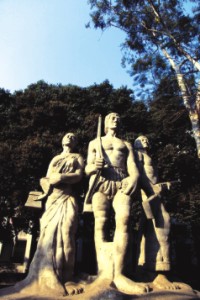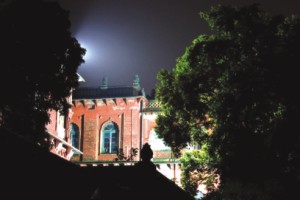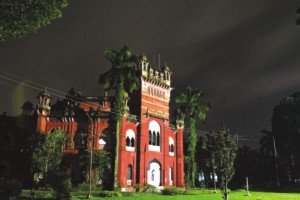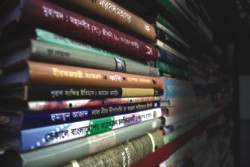Dhaka University Diaries
The Tenant
By Shaer Reaz
 |
Photo: Zabir Hasan |
9 AM: The soft chirping of birds in the tree beside my window wakes me. Thankfully, the day being Saturday, there are no annoying sounds of children doing P.E. in the school right next to my building. I do miss being jerked out of sleep by the national anthem though, however out of tune it is.
10 AM: After much stretching and yawning, it's time for breakfast. The options are limitless - Hakim chattar for shingaras and puris, head to Polashi bazaar for a classic meal of egg omelettes and parata; maybe Dutch Cafeteria for something a little more modern? Anything I choose is rewarding to the taste buds, without leaving any noticeable dent on the wallet.
12 AM: Weekends are all about slacking off. Going for a walk around campus is the perfect way to unwind after a week of hectic classes and assignments. Starting off along Fuller Road, there are telltale signs of the weekend laziness: a guard at the British Council stifling a yawn, a cat stretching in the warm sunlight, a couple walking slowly while holding hands. Great places for daydreaming in the noon sun are the pond shores. The bigger pond in Shahidullah Haq Hall offers more things to see; the scenic gardens and British era buildings provide suitable backdrops for an outing alone or with friends. The Jagannath Hall pond is slightly less classy, but still a good place for a "hangout".
3 PM: Cricket or football, whichever you prefer, the Dhaka University campus can facilitate both. Demand doesn't exactly meet supply though, as outsiders have to vacate as soon as the locals get to the fields. Being a local gives one a definite advantage, it may not exactly be fair, but in a country like ours, you shouldn't expect much to be fair anyway.
7 PM: After a tiring game of cricket or football, there's nothing like gathering at the local street shop and sharing a bottle of coke. This is the time when the bikers from Old Dhaka come out to play, almost invariably with a bunch of policemen at their tails asking them to stop. A microbus follows, with a loudspeaker asking the groups of outsiders and the couples on the sidewalk to leave as the area is restricted after dark. It isn't, but they leave anyway.
11 PM: Probably the only place in Dhaka where you can head out for a cup of tea with a couple of friends and actually find a tea shop and not get mugged in the process. There is no place like the DU campus if you fancy a night excursion. Some places like Polashi bazaar and the tea stalls in Mohsin Hall (beside the Senate building) stay open deep into the night, whether you want a cup of tea, a midnight snack of dim-bon or shingaras, or a pack of unhealthy white sticks. The incredible, unseen bashiwalas with their magical flutes provide the perfect atmosphere.
The Dhaka University campus is truly a unique place to live in. Where else would you have access to a fast internet connection for only a Tk 100 per month? For the past seventeen years of my life I have had an uninterrupted electricity supply. Where else in Dhaka would you ever imagine being woken up by birdcalls? The countless gardens, ponds and trees make this one of the most beautiful places in Dhaka. School of Learning indeed.
University of Dhaka
A View from the Outside
By: Sabhanaz Rashid Diya
“Ai, Nirob e jabi?”
“Dara, lassi'r bill ta pay kore ashtesi…”
 |
Photo: Mohammad Moniruzzaman |
I turned and began searching my bag for a twenty taka bill, while Nashrah - my partner in crime for the day went scouting for a rickshaw. The afternoon sun was scorching behind TSC as flocks of couples and friends were coming in and out to order the famous thanda lassi from the shop across the street. TSC (Teacher Student Centre), a landmark of the University of Dhaka area has a charm of easing people into its familiarity. The series of little desks, placed like dominoes at the gate of the Centre campaigned year round for this activity or the other, while mamas across the street seemed to have an unending supply of ovaltine chaa, bhelpuri, phuchka, lobon shosha, jhal peyara, tok aam and muraali-batasha. Anyone, be it from the university or outside could loiter around the area, feeling just an integral part of it as someone who has lived there for decades.
Our rickshaw skidded past cars and buses. Anyone with the slightest curiosity towards visual arts will find treasure in this part of town. The overshadowing krishnochura or the 10-feet tall stilt walker with his bohurupi attires - there is always a facet to paint, photograph or carve at every nook of the campus area. My fingers kept clicking the shutter, capturing a face there, a motion here, a lazy rickshaw puller now, a strange graffiti somewhere… moments were everywhere. It's enthralling as to how much diversity this place has to offer!
A jolted halt in front of Nirob and we were suddenly surrounded by adda, food and noise. Nirob is a popular restaurant at Chankharpool, a 10-minute rickshaw ride from TSC. The place has a unique menu comprising rice, bhorta and vegetables, and is a great place to hang out. On the outskirts of the university area, the place has an array of famous food restaurants such as Mamun Biriyani, Nanna Miya, Shohag Hotel and street bakorkhani. Every mouth watering Old Dhaka delicacy has found its niche at Chankharpool making it a hotspot for students and visitors from the university. Our next stop was Charukola.
Charukola has an inspiring quality of being serene and spirited at the same time. Art students sketch or paint, photographers find their muse amidst the greenery or stone sculptures, poets cherish a quiet spot for some reflections, and visitors like us rediscover another side of the growing metropolis. We found a group of youth humming familiar notes under the shades of the great banyan tree inside Charukola, and joined the crowd. It's almost poetic as to how random strangers can be united through chaa and guitars, especially when it comes to Dhaka University. Charukola has something to offer to anyone and everyone. The Joynul Gallery on the ground floor or Chhobi Haat across the street is always bustling with activity, and provides a unique and memorable experience to anyone who comes across it. While University of Dhaka remains an important academic and research centre in South Asia, for the avid commoner, it remains a place to experience, relive and rediscover the many aspects of Bangladesh. Be it an adda, a photo hunt, a heritage site, a place to roam around or some moment of seclusion, it responds to any need of the soul. Despite the many controversial political movements, it remains today as a much loved, cherished and historically significant location for people from all parts of the country.
And the students say….
By Raisa Rafique
 |
Photo: Mohammad Moniruzzaman |
Many years ago a little kid went to visit a place in Dhaka with her uncle. It was a huge place so they kept walking and walking. There were sombre-looking buildings and people holding books everywhere; laughing and chatting in merriment as the kid watched with wide eyes. A group of people were singing patriotic songs in a corner while another group was busy upon a stage participating in a play. Boimela was going on a bit farther ahead and there was so much festivity in the air! The kid looked up in amazement and found the uncle smiling, “Behold, the University of Dhaka. Some day you too will be a part of all this.”
That's how it all started for yours truly.
Studying at DU had always been a dream, therefore the rush of relief and the newfound sense of belonging that came with the admission test results, felt simply other-worldly. It's been three years since then. So what IS studying at DU really like?
Enlightening- is the first word that comes to mind. University is a whole new level in a student's life and DU makes sure its students are provided with a complete uni-experience. A huge campus, separate faculty areas, libraries (central, science, public, departmental, dorm. and so on), gymnasium, swimming pool, huge playing fields, TSC, IML (Institute of Modern Language), numerous clubs for students, clubs for teachers, medical concessions- DU has it all. From flower shops to cheap eateries, everything is within arms reach. Also the most important element for influencing impressionable minds- some of the best and coolest teachers of the country belong to this university. You don't always have to be a nerd to like their classes.
Turbulence- Youth is power. Power-struggles, gunfights, murder have become regular incidents and innocent students are getting tangled in the deadly web that is student politics.
System Loss- Too many students, too little accommodation facilities. Roughly 2000 students live in a male dormitory with capacity for 500 only (according to Muhsin Hall Provost). How they make it possible, Lord knows best. Same goes for the female dorms as well, although a tad less severe in their case. Also there's the monster called session-jam. The Humanities faculty is the main victim in this case, some subjects enduring up to 5-6 years of session-loss.
The Price of Fame… and PDA- The birthplace of the great War and the Language Movement, the centre of cultural flourish and the proud venue of yearly Boimela: DU has always been a place of great interest for the common people. And so it gets flooded with people on every occasion and sometimes without any concrete reason. And let's not forget the hundreds of couples that leave no spot unturned.
So there you have it. Studying at DU is just like living in Dhaka: you have ups, you have downs, and still you love it. Because it's all part of growing up and being strong.
 Momtaj
Momtaj
Those ignorant of cricket can be forgiven for mistakenly believing Nantu Ghotok to be the theme song for the 2011 ICC World Cup. It's played in the gallery when Shafiul grabs a wicket, when Tamim hits a six, when Mushfiqur takes a catch, when Ashraful sweeps one to backward sqaure, when Shakib wins the toss and makes his call. Momtaj sang it in the opening ceremony. With her stream of lyrics getting constantly broken, torn, cracked, burned, etc, Momtaj is now an official Bangladesh icon. You will groan at her songs and yet you will dance. Because she is Momtaj. She is legend.
By Professor Spork
The Wall Posts
We're not talking about the silly gang-graffiti that haunt the sleep of house owners in posh areas of Dhaka. We're talking about the real wall-writings. Starting from political messages demanding the release of someone from prison, to advertisements of products; from nice little poems and words of inspiration on national days, to explicitly personal messages like “Koste asi- Aijuddin”, the writings on the wall, eye-sores or not, is an integral scene on the streets and walls of Bangladesh, not just the capital or the big cities.
By Jawad
Sounds of Bangladesh
Scream, yell, honk, thoo! Momtaj in the background, with construction men working to the beat. Rickshaw bells tinkling, CNGs grumbling along, crows insistent in their cacophony. And at last the highway approaches. Cows and goats occasionally make their presence felt. As the village draws nearer, everything goes quiet. The stillness gives the azaan a powerful, haunting feel. Night livens things up with its own set of sounds. A train passes in the distance. Crickets chant to the darkness. As midnight closes in, a heartbroken lover sings his soul out. The cats stop yowling and listen. This country never sleeps.
By TheAlien4mEarth
Dholaikhal
NOWHERE else on earth (probably) will you be able to find a collective of car parts sellers so hell bent on making you buy a car part that you don't need at all. They boast an almost gargantuan inventory of car parts, from the regular run of the mill Corolla parts to rare powerful GT engines all collecting dust on the grimy floors, until you come along and buy it at exorbitant prices. The way they run things, they could set up their own F1 team.
It's a Nilkhet for car parts, so we got to love it.
By Shaer Reaz
The One that Mops
The fine printed, silky ones with an eye-catching striped-pattern are probably the most used towels in this world, because of the sheer number of people in Bangladesh that regularly use them. Gamchas are a brand now. Although its effectiveness in drying can be questioned, its availability and price is really suitable for the general masses. And it sort of brings out the solidarity. Gamcha draped over your shoulders or tied on your forehead really fills you with 'Bangalipana'.
By Jawad
Nilkhet
 |
Photo: Kazi Tahsin Agaz Apurbo |
Nilkhet isn't just about the books, although the books are central. It's also about the side stores that'll copy, photocopy, print, fax, mail and forge anything for you with some seriously expensive equipment. Coming back to the books, there aren't many you can't find in Nilkhet. Starting from school textbooks, to books of O'level coaching notes, storybooks you'll find everywhere, to the most revered Iliad translation, they're all here, waiting for you to search them out. Collectors from all over the country and students all over the city make regular trips here. Forty greatest things? Nilkhet would make top five!
By Professor Spork
